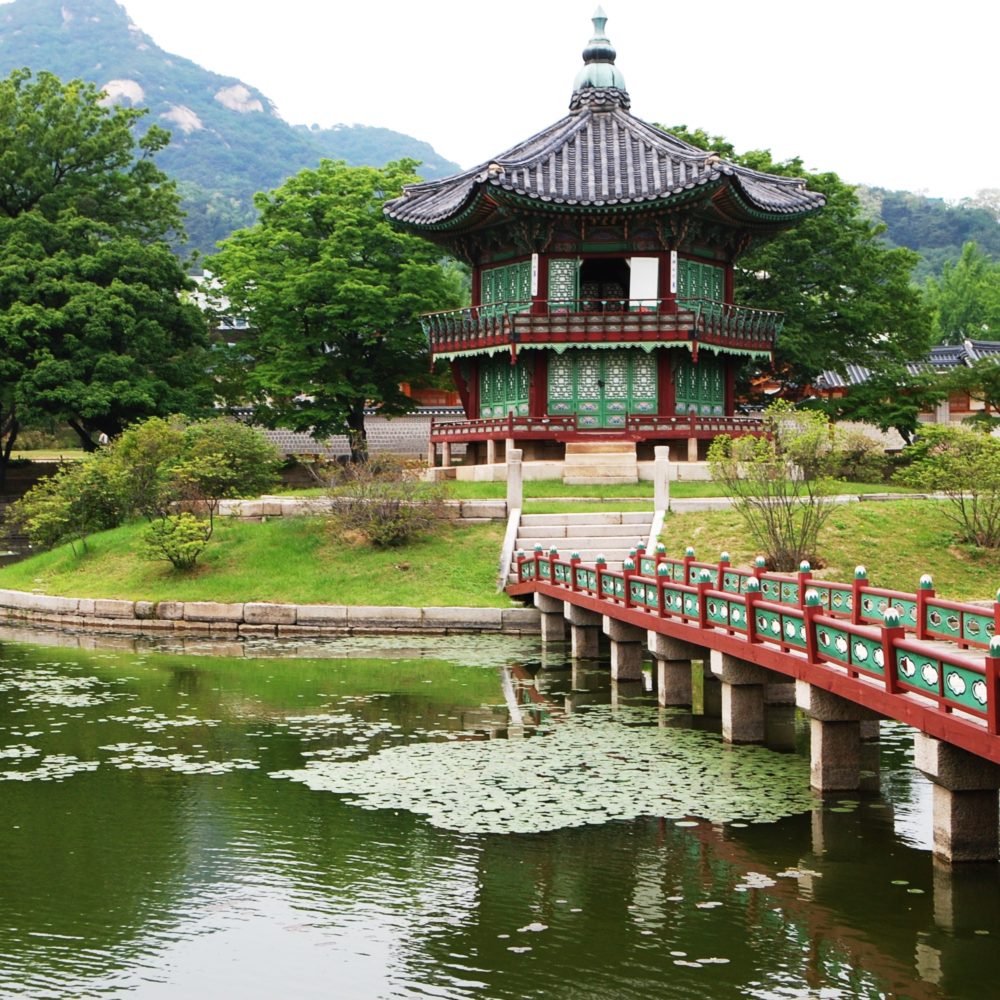SEOUL
South Korea. The country which occupies the southern part of the Korean Peninsula, also known as “Korea,” and officially named “The Republic of Korea.”
http://en.wikipedia.org/wiki/South_Korea
Seoul. The capital city of South Korea.
http://www.britannica.com/EBchecked/topic/534948/Seoul
Geyongju. An historic city in the eastern part of South Korea.
http://www.buddhistravel.com/index.php?id=66,647,0,0,1,0
Jeonju. The tourist destination and capital city of South Korea’s North Jeolia Province.
http://en.wikipedia.org/wiki/Jeonju
Shopping:
Myeong-dong. One of Seoul’s main shopping and tourist districts.
http://en.wikipedia.org/wiki/Myeongdong
Namdaemun. A shopping area in Seoul.
http://www.visitkorea.or.kr/enu/SH/SH_EN_7_2.jsp?cid=273760
Hongdae. An entertainment district in Seoul.
http://en.wikipedia.org/wiki/Hongdae_area
Temples:
Jogyesa Temple. The central Seoul temple established in 1395.
http://english.visitkorea.or.kr/enu/SI/SI_EN_3_1_1_1.jsp?cid=264352
http://en.wikipedia.org/wiki/Jogyesa
GuinsaTemple. Korea’s major Buddhist temple.
http://en.wikipedia.org/wiki/Guinsa
Bulguksa Temple. A Buddhist temple which dates back to the 8th Century and is rated by the Korean government as the country’s top historic and scenic site.
http://en.wikipedia.org/wiki/Bulguksa
Haeinsa Temple. A Buddhist temple in Korea’s South Gyeongsang Province, one of the “Three Temple Jewels,” and the home of the Tripitaka Koreana Buddhist scriptures.
http://english.visitkorea.or.kr/enu/SI/SI_EN_3_1_1_1.jsp?cid=264238
Gyeongbokgung Palace. The main palace of the Joseon dynasty.
http://english.visitkorea.or.kr/enu/SI/SI_EN_3_6.jsp?cid=262361
Hahoe Folk Village. A traditional village which preserves the Joseon Dynasty style.
http://en.wikipedia.org/wiki/Hahoe_village
Gyeongju. A coastal city and tourist destination in South Korea’s North Gyeongsang province which is the former capital of the 7th to 9th Century kingdom of Silla.
http://en.wikipedia.org/wiki/Tourism_in_Gyeongju
Silla. A Korean kingdom from the 1st Century to the 10th Century.
http://en.wikipedia.org/wiki/Silla
Tripitaka Koreana. The Haeinsa Temple’s 13th Century Korean collection of Buddhist scriptures.
http://www.answers.com/topic/tripitaka-koreana
Jeonju. The capital of Korea’s North Jeolia Province and a tourist destination.
http://en.wikipedia.org/wiki/Jeonju
Gwangjang. A Seoul district known for its food market and other shopping.
http://english.visitkorea.or.kr/enu/SH/SH_EN_7_2.jsp?cid=273761
Norea Bang. A Korean karaoke center and a popular form of entertainment in Korea.
http://koreansdig.wordpress.com/
Where we stayed in Seoul:
Park Hyatt Seoul. A luxury hotel in Seoul.
http://seoul.park.hyatt.com/hyatt/hotels/index.jsp
Where we ate:
Suji’s. Where to go if you just have to have a pastrami sandwich or omelette. www.sujis.net
SeoulEats.com. A blog written by Daniel Gray, an expat American of Korean descent who lives in Korea’s capital. Seouleats.com
Busan Jib. where I had an unforgettable dinner of marinated crab and Agu Jjim, chunks of steamed monkfish sautéed in Korean red pepper sauce (gochujang) with bean sprouts.
http://blog.naver.com/202xender?Redirect=Log&logNo=140061552395
Kwang Jang Market. Rickety tables and tiny stools serve as pop-up restaurants.
Rudy’s food notes:
Eating Korea: Food Puts the Soul in Seoul
Three syllables kept going through my mind as my plane flew across the Pacific Ocean headed for Seoul, the capital of Korea: bi-bim-bap. Like the riff of a snare drum, the syllables kept repeating: bi . . . bim . . .bap.
Bibimbap (say it very quickly this way: “bee-bim-bop”) is one of the most popular dishes in Korea, and restaurants from Koreatown in Los Angeles to Korean restaurants in London offer it. But now I was headed into the heart of bibimbap territory, the crucible in which the dish was forged, the mother ship of bibimbap.
Like most Asians, Koreans take what they eat seriously. Sure, there are Pizza Huts, KFCs, and other American, fast-food restaurants in Korea, but the magic is found elsewhere.
In Seoul’s cavernous Kwang Jang Market, http://www.visitkorea.or.kr/enu/SH/SH_EN_7_2.jsp?cid=273761 rickety tables and tiny stools serve as pop-up restaurants.
Tiny eateries tucked in Seoul’s alleyways specialize in one or two dishes, such as a restaurant called Busan Jib, http://blog.naver.com/202xender?Redirect=Log&logNo=140061552395 where I had an unforgettable dinner of marinated crab and Agu Jjim, chunks of steamed monkfish sautéed in Korean red pepper sauce (gochujang) with bean sprouts.
It’s always a good idea to hook up with a local to learn where they dine, and Sujin Park–a Seoul resident who worked in New York City and returned home with such a love for deli food that she opened several of her own delis in Seoul—hosted me to that dinner at Busan Jib.http://blog.naver.com/202xender?Redirect=Log&logNo=140061552395
Our “fixer” during my week of shooting one of my public television episodes in Korea, was Kim Ji Sung, and it was he who led me on day six of our shoot to the ultimate dish of bibimbap.
To Americans, the most famous Korean specialty is Korean barbeque, a feast of beef, pork or chicken that you cook for yourself over an open charcoal or gas flame at your table along with thinly sliced garlic and other seasonings. Korea’s major addition to the wide world of barbecue is a panoply of side dishes called banchan that invariably include kimchi– fermented vegetables (usually cabbage with peppers)–and a host of other small sides such as cucumbers stuffed with chili and spring onions, radishes, and spicy sauces.
While I ate mainly beef, the specialty of a barbecue restaurant in one small town in Korea was pork, as the enormous drawing of a pig’s head on the front window indicated. Inside, we were presented with super-sized slabs of bacon—thick with fat—that would have warmed a cardiologist’s heart.
For bibimbap, our guide, Ji Sung, waited until we arrived at the home of the dish, the city of Jeonju, the Joseon Dynasty’s spiritual capital where aristocrats perfected the art of the dish. Here, I knew I was at The Source.
Bibimbap is a happy marriage of vegetables, rice, raw egg, raw beef, and sauce that arrives as a colorful symphony of flavors. The Jeonju version differed from bibimbap I’d had at Korean restaurants in the US—it wasn’t served steaming hot in a pan. (In that version, the burnt scrapings from the bottom of the metal pan in which it was cooked are coveted; usually the guest of honor gets the lion’s share of that crispy portion.)
But here in the heartland, my bibimbap arrived warm in a brass bowl, meant to keep the rice moist. It was as beautiful as a still-life painting, but I wasted no time mixing the ingredients with my metal chopsticks–Koreans only use metal chopsticks, a holdover from royalty who favored silver ones that would change colors if an enemy had snuck poison into a dish.
The first bite was a mélange of sweet and spicy, soft and crunchy. Bean sprouts, mushrooms, sesame spinach, the beef that had been warmed by the rice, the raw egg that made the entire offering moist . . . all conspired to deliver what could truly be termed an entire meal in one bite.
This, I often think to myself, is one reason why I love to travel. Like sampling pizza in Naples or a green-lipped mussel on a boat hauling in the catch in New Zealand’s waters, going to the source addresses a personal quest for the authentic.
I had another food experience quite different from the rest, something that in Korea is called a “temple meal” or balwoo gongyang. Temple stays http://www.visitkorea.or.kr/enu/SI/SI_EN_3_4_6.jspare popular in Korea, where monks open their campuses to overnight stays by guests who are willing to abide by a few rules. (Among them: rising VERY early in the morning.) Meals are taken on a communal basis, and often silence must be observed while eating.
The crew and I stopped in a temple for lunch, and while we were permitted to converse, we all had to be members of the Clean Plate Club. Every scrap of food on one’s plate had to be eaten or no one in the temple would be permitted food the next day, a punishment that could affect hundreds of residents.
I thought I’d followed the rules until the genial monk who was our guide pointed out through our translator that there were still some grains of rice left on the side of my bowl. Be warned: Finishing everything means not leaving a single grain of rice uneaten.







